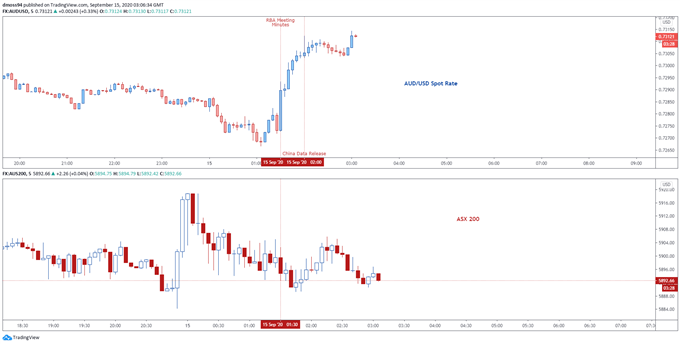Chinese Retail Sales, Industrial Production, Trade Tensions, AUD/USD, RBA – Talking Points:
- Better-than-expected Chinese retail sales and industrial production figures for August fueled the Australian Dollar’s surge back above the 0.73 level.
- Escalating Australia-China trade tensions could hamper AUD in the near term.
- RBA flagging additional monetary measures may cap AUD/USD rates.
The Australian Dollar stormed back above the psychologically imposing 0.73 level after Chinese retail sales and industrial production figures for August showed the local economy is continuing to rebound robustly from the doldrums of January.
Given Australia’s reliance on its largest trading partner, it comes as no surprise that the fifth straight month of increase in industrial output and the first increase in retail trade since December 2019 notably buoyed the trade-sensitive currency.
However, the deteriorating relationship between the two nations may dampen the overall impact of the positive economic data release on the AUD/USD exchange rate, as Beijing intensifies its attack on Australian exports.

AUD/USD and ASX 200 Index chart created using TradingView
Beijing Targets Australian Exports
Escalating tensions with China may hamper the trade-sensitive AUD as China’s General Administration of Customs imposes “enhanced inspection” measures on Australian wheat.
This follows on from the imposition of 80% tariffs on Australia’s barley exports in May, after Prime Minister Scott Morrison called for an independent investigation into the origins of Covid-19 and suspended the nation’s extradition treaty with Hong Kong in response to the national security law imposed by China.
Clearly Beijing is unhappy with the Australian Government’s interference in “China’s internal affairs” and may continue to target the export-driven economy in the run up to US elections.
Moreover, falling demand for Australia’s most valuable export could begin to hamper the performance of the commodity-sensitive AUD, as global demand for iron ore appears to have plateaued.
Exports of iron ore have notably levelled off since peaking in early June and may be a contributing factor to the AUD/USD exchange rate’s recent struggle to push above the 0.74 mark.
Therefore, the imposition of further retaliatory measures could significantly weigh on the Australian Dollar in the near-term as stabilizing iron ore prices fail to counterbalance the revenue lost to restrictions on agricultural products.

Data Source – Bloomberg
RBA Expected to Cut Rates in October
The extension of stage-four restrictions in Melbourne, Australia’s second largest city, may force the hand of the Reserve Bank of Australia at its upcoming meeting on October 6, with the central bank expected to clarify the statement that “the Board will maintain highly accommodative settings as long as is required and continues to consider how further monetary measures could support the recovery”.
This statement may imply that the RBA is looking to build on its decision “to increase the size of the Term Funding Facility and make the facility available for longer” at its last meeting, despite the central bank’s assessment that “the downturn is not as severe as earlier expected and a recovery is now under way in most of Australia”.
However, what those “further monetary measures” may look like is relatively unknown given the central bank already utilizes yield curve control (YCC) and has been openly dismissive of the effectiveness of a negative interest rate policy (NIRP) and foreign exchange intervention.

Source – ASX
That being said, Governor Philip Lowe had previously flagged a list of potential measures “using international experience as a guide” that would allow the board to reconfigure its monetary policy settings “if developments in Australia and overseas warrant doing so”.
Lowe stated that “the various interest rates currently at 25 basis points could have been set lower, at say 10 basis points [and] it would also have been possible to introduce a program of government bond purchases beyond that required to achieve the 3-year yield target”.
Clearly the market took heed of the Governor’s comments, with futures markets pricing in a 69% chance that the RBA cuts the official cash rate (OCR) to 0% on October 6.
Although a complete 25 basis point cut seems relatively unlikely, a package inclusive of a cut to 0.1% and an enhanced government bond purchasing program could be in the offing.
To that end, upcoming employment data for August may dictate the short-term outlook for the Australian Dollar, with a greater-than-expected rise in unemployment increasing the likelihood that the RBA will act in October and in turn hampering the performance of the local currency.

-- Written by Daniel Moss, Analyst for DailyFX
Follow me on Twitter @DanielGMoss







